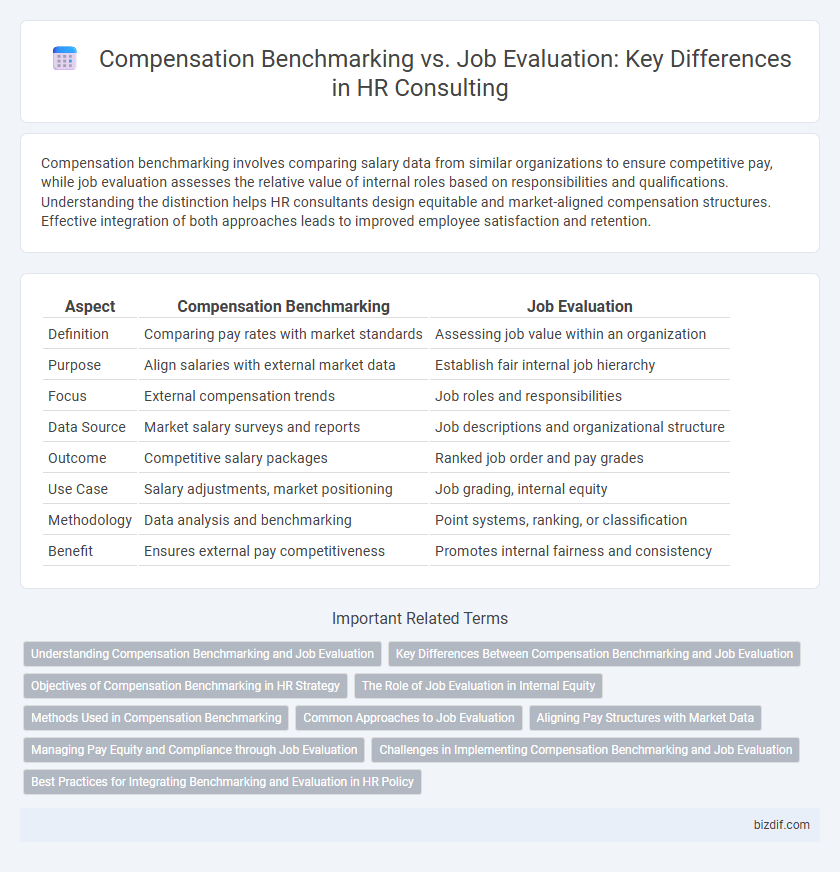Compensation benchmarking involves comparing salary data from similar organizations to ensure competitive pay, while job evaluation assesses the relative value of internal roles based on responsibilities and qualifications. Understanding the distinction helps HR consultants design equitable and market-aligned compensation structures. Effective integration of both approaches leads to improved employee satisfaction and retention.
Table of Comparison
| Aspect | Compensation Benchmarking | Job Evaluation |
|---|---|---|
| Definition | Comparing pay rates with market standards | Assessing job value within an organization |
| Purpose | Align salaries with external market data | Establish fair internal job hierarchy |
| Focus | External compensation trends | Job roles and responsibilities |
| Data Source | Market salary surveys and reports | Job descriptions and organizational structure |
| Outcome | Competitive salary packages | Ranked job order and pay grades |
| Use Case | Salary adjustments, market positioning | Job grading, internal equity |
| Methodology | Data analysis and benchmarking | Point systems, ranking, or classification |
| Benefit | Ensures external pay competitiveness | Promotes internal fairness and consistency |
Understanding Compensation Benchmarking and Job Evaluation
Compensation benchmarking involves analyzing competitive salary data from similar industries to ensure pay scales are market-aligned and attract top talent. Job evaluation systematically assesses job roles based on responsibilities, skills, and effort to establish internal pay equity. Understanding both processes is essential for designing fair, competitive compensation structures that support employee retention and organizational performance.
Key Differences Between Compensation Benchmarking and Job Evaluation
Compensation benchmarking involves comparing an organization's salary ranges with external market data to ensure competitive pay structures, while job evaluation systematically assesses internal job value based on criteria like skills, responsibilities, and effort. Benchmarking focuses on aligning compensation with external market trends, whereas job evaluation emphasizes internal equity by ranking jobs relative to each other. The key difference lies in benchmarking's market-driven approach versus job evaluation's internal, systematic assessment of job worth.
Objectives of Compensation Benchmarking in HR Strategy
Compensation benchmarking in HR strategy aims to align an organization's pay structures with industry standards to attract and retain top talent while ensuring internal equity. It involves analyzing market salary data to establish competitive and fair compensation packages that support business goals. This process helps organizations maintain cost efficiency and enhance employee satisfaction by providing transparent, market-driven compensation frameworks.
The Role of Job Evaluation in Internal Equity
Job evaluation plays a critical role in maintaining internal equity by systematically assessing the relative value of each position within an organization based on factors such as skills, responsibilities, and working conditions. This process ensures fair compensation structures, preventing wage disparities and fostering employee satisfaction. While compensation benchmarking aligns pay with external market rates, job evaluation provides the foundational framework for consistent and equitable pay decisions internally.
Methods Used in Compensation Benchmarking
Compensation benchmarking employs methods such as market pricing, where salaries for comparable roles in similar industries are analyzed to establish competitive pay levels. Salary surveys and third-party compensation databases provide quantitative data that HR consultants use to align compensation packages with market standards. These techniques ensure organizations maintain equitable pay structures and attract top talent effectively.
Common Approaches to Job Evaluation
Common approaches to job evaluation in HR consulting include ranking, classification, point-factor, and factor comparison methods. Ranking involves ordering jobs from highest to lowest based on overall value, while classification categorizes jobs into predefined grades or classes. Point-factor systems assess jobs against compensable factors such as skills, responsibilities, and working conditions, providing a quantitative basis for compensation benchmarking.
Aligning Pay Structures with Market Data
Compensation benchmarking leverages external market data to align pay structures with industry standards, ensuring competitive salary offerings that attract and retain top talent. Job evaluation systematically assesses internal job roles based on responsibilities and requirements to establish equitable pay hierarchies within an organization. Integrating compensation benchmarking with job evaluation creates a balanced pay structure that reflects market conditions while maintaining internal pay equity.
Managing Pay Equity and Compliance through Job Evaluation
Job evaluation provides a systematic approach to assessing the relative worth of jobs within an organization, ensuring consistent pay equity by eliminating subjective bias. This method supports compliance with labor laws and regulations by establishing transparent, defensible compensation structures based on job responsibilities and requirements. Integrating job evaluation with compensation benchmarking allows HR professionals to align internal pay equity with external market rates, optimizing total rewards strategy and reducing legal risks.
Challenges in Implementing Compensation Benchmarking and Job Evaluation
Implementing compensation benchmarking faces challenges such as obtaining accurate and up-to-date market data, addressing industry-specific pay variations, and ensuring internal equity while remaining competitive. Job evaluation struggles with converting qualitative job factors into quantifiable metrics, managing employee perceptions of fairness, and maintaining consistency across diverse roles and departments. Both processes require continuous updating to reflect organizational changes and evolving market conditions, complicating the alignment of pay structures with strategic HR goals.
Best Practices for Integrating Benchmarking and Evaluation in HR Policy
Effective HR policies integrate compensation benchmarking and job evaluation by aligning internal job worth with external market data to ensure competitive and equitable pay structures. Utilizing data from reliable salary surveys alongside a systematic job evaluation method enhances decision-making accuracy and fosters transparency in compensation management. Regularly updating both benchmarking data and job evaluations maintains policy relevance amid changing labor market conditions and organizational dynamics.
Compensation Benchmarking vs Job Evaluation Infographic

 bizdif.com
bizdif.com